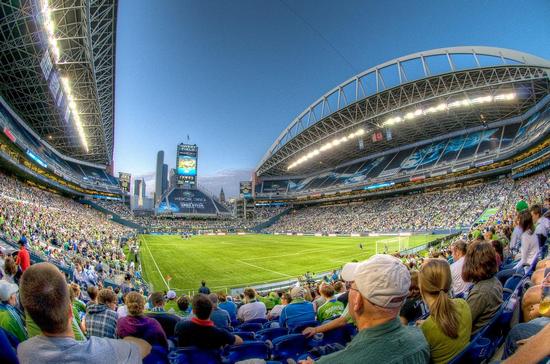25
Major League Soccer is Enjoying Growth on Both Global and Financial Scales
No comments · Posted by Alex Smirnov in Sports
For so long, the popularity of professional soccer in the United States has trailed dozens and dozens of other countries. Aside from more impassioned interest during World Cup years, soccer has been viewed as more of a niche sport inside the USA, one that not only lagged in recognition compared to other nations around the world but also registered as little more than a blip on the radar of other North American staples like football (NFL, NCAA), basketball (NBA), baseball (MLB) and hockey (NHL).
Recently, however, things have started to change. Major League Soccer (MLS) has never been more popular in the United States. Signs of growth have become undeniable.

“Qwest Field from the Southwest corner during a MLS Seattle Sounders FC Match” is licensed under CC BY 2.0
Founded in 1993, MLS is enjoying a boom in interest. Fanbases are growing. More teams have entered the league. Sponsorships are mushrooming in number and total value. The best sportsbooks in the USA have expanded their MLS betting offerings and even inked partnerships with the league and its teams. The playoffs and MLS Cup Final are now hot-button events that get additional air time on both television and streaming services.
The surest signs of growth, though, lie with MLS’ talent pool and the value of their franchises. Both are on the rise in a big way.
Major League Soccer is the Most Geographically Diverse League in North America
As the popularity and the competition level of MLS have ascended, the crop of incoming talent has become more impressive. MLS clubs now have the money and clout to sign bigger international names from other leagues.
The end result of this talent infusion isn’t just a better product on the pitch, though that’s certainly one benefit. With clubs now chasing and bagging international stars, MLS has developed into one of the most geographically diverse pro sports leagues in the United States.
And that’s actually an understatement. According to a recent article from MLS communications, there is no pro sports league in North America with more international representation:
“With players from 81 countries across six continents represented on 2023 rosters, Major League Soccer features the most geographically diverse and youthful player pool of any top men’s professional league across North America. The 81 countries represented, as determined by birthplace as of April 20, marks the second consecutive year that players from 80 or more countries have appeared on MLS rosters and makes MLS the most globally diverse player pool among top North American men’s professional sports leagues.”
No other North American league comes close to sniffing the number of countries represented on MLS rosters. The NBA finishes in second place, with 45 countries accounted for in their player pool. That’s barely half of the 81 in MLS. Third place, meanwhile, is even further away. The NFL has 31 countries represented on their rosters. That’s a little more than one-third of MLS’ geographical profile. The NHL (25 countries) and MLB (21 countries) are light years away, as well.
But Wait, MLS is Also Actually the Most Geographically Diverse Soccer League in the World
It turns out MLS’ geographical representation among players isn’t just unique to sports in the United States. It carries global significance.
This year, MLS is also “the most globally represented league among the top men’s soccer leagues around the world,” per MLS communications.
At first glance, this reads like a typo. Surely MLS doesn’t have more international players than a powerhouse entity like Italy Serie A? Or the English Premier League? And yet, this is exactly the case.
You can see for yourself below. Here are the number of countries represented in the six most popular soccer leagues around the globe:
1. MLS – 81 countries
2. Italy’s Serie A – 69 countries
3. English Premier League – 66
4. France’s Ligue 1 – 63
5. Germany’s Bundesliga – 61
6. Spain’s LaLiga – 59
This is quite the development. And it’s likely not one many saw coming a decade ago. Or even a half-decade ago. MLS clubs have always been willing to poke around bigger international names, but these players seldom wanted to head stateside while still in or around their primes. Though that trend persists to some degree, it isn’t nearly as prevalent. At the very least, it’s clear that MLS has done enough to ever so slightly increase its global prestige both international fans and talent.
MLS Franchise Values are Rising Right Along with Their Popularity
Major League Soccer’s popularity at home and around the globe isn’t the only thing on the come-up. Club valuations have started rocketing upward, too.
To be sure, MLS doesn’t yet have a $1 billion club on their hands. The Los Angeles FC received the highest valuation for 2023, at around $900 million, according to Sportico. That figure represents a 5 percent increase year-over-year, and it’s part of a larger trend that has seen MLS franchise values explode.
For context, here are the top 10 MLS franchise valuations for 2023, per Sportico:
1. Los Angeles FC – $900 million
2. LA Galaxy – $865 million
3. Atlanta United – $855 million
4. Seattle Sounders FC – $725 million
5. Toronto FC – $705 million
6. D.C. United – $700 million
7. New York City FC – $690 million
8. Portland Timbers – $685 million
9. Austin FC – $630 million
10. Inter Miami CF – $585 million
Many wondered whether the recent uptick in MLS expansion franchises would dilute the league’s growth. It has done the opposite. At present, the current average value of an MLS franchise is more than $580 million. That represents a 55-plus percent increase from the average of just a few years ago.
This growth doesn’t feel real. But the proof is etched in stone. Consider Los Angeles FC, which is now MLS’ most valuable franchise. Forbes estimated their value in 2019 to be approximately $475 million. Fast forward roughly four years, and their valuation has increased by $425 million – almost 90 percent. That is patently bonkers.
Granted, this growth won’t last forever. It has already leveled off. Only a handful of MLS franchise values in 2023 are up double-digit points year-over-year. But that’s not a harbinger of regression. Franchise values are still increasing at an above-average rate overall. And given the United States’ burgeoning demand for professional soccer, there’s no reason to assume MLS’ growth will taper off anytime soon.
Tags: No tags
You might also like:
<< Best Ukrainian Universities to Study In






